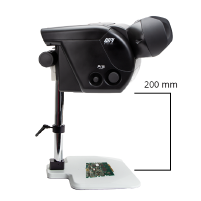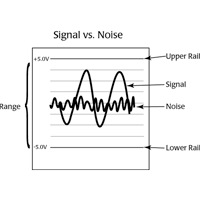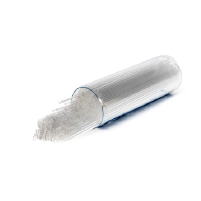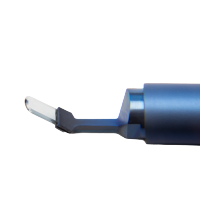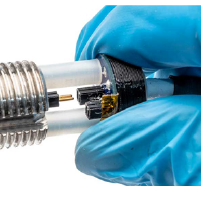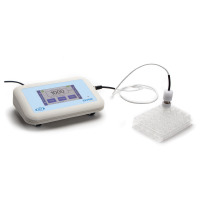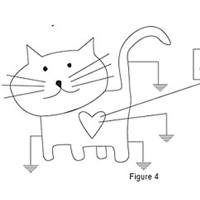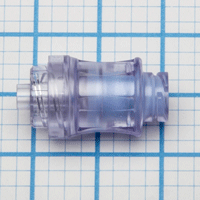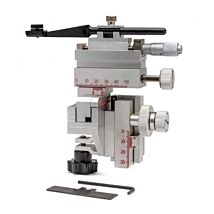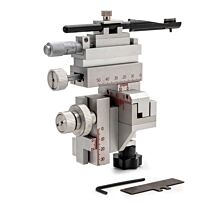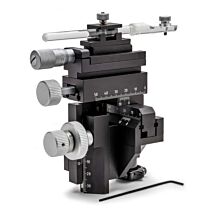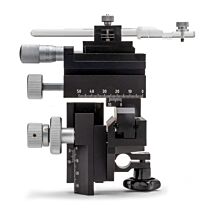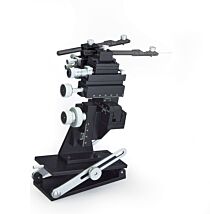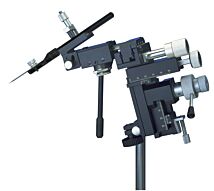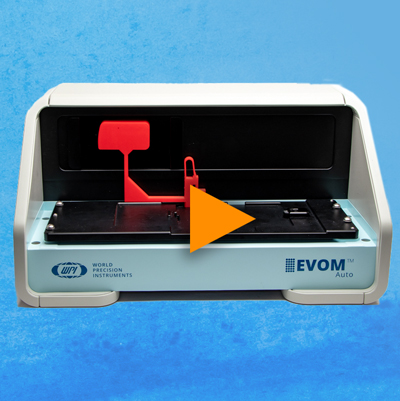This website uses cookies to ensure you get the best experience on our website.
Read more
How to Read a Vernier Scale
April 08, 2021
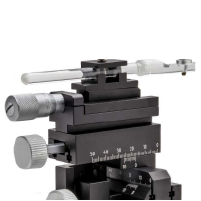
Vernier scales can be used on microscopes, stereotaxic frames and micromanipulators. The vernier scale was invented by French mathematician Pierre Vernier in 1631 as an upgrade on Pedro Nunes' measurement system for precision astrolobes. With a main scale and a sliding secondary scale, a vernier is used for making precise measurements.
How a Vernier Scale Works
The vernier scale is marked with divisions slightly smaller than the divisions of the main scale. For example, a vernier scale could have 11 markings for every 10 on the main scale. That's 10 divisions on the vernier scale for every 9 on the main scale. This means that the vernier divisions are each 90% of the main scale divisions. In this case, the 0-line and the 10-line on the vernier could pair up with marks on the main scale, but none of the other divisions on the vernier would match a line of the main scale. For example, the 0 and 10-lines of the vernier scale could pair up with the 0 and 9-lines on the main scale. If the 0-line pairs up with a mark, the first division of the vernier (1 mark) would be 10% short of reaching a mark of the main scale, the second division (2 mark) would miss a mark on the main scale by 20%, the third division (3 mark) would miss a mark on the main scale by 30%, etc.
How to Read a Linear Vernier Scale
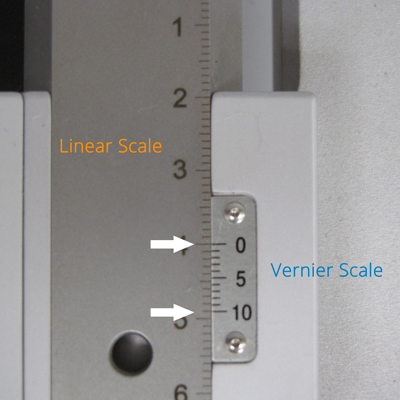
Follow these steps to read the vernier scale:
-
Read the main scale. Look for the last whole increment visible before the 0 (zero) mark.
-
Read the secondary scale (Vernier) measurement. This is the division tick mark that lines up best with a mark on the main scale.
-
Add the two measurements together.
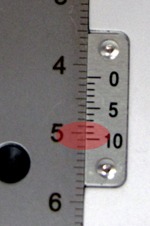 The image at the right shows a linear scale. The 0 on the vernier scale lines up with the 4 on the main scale. Notice that the 10 on the vernier scale also lines up with a mark on the main scale (4.9). We ignore the second mark that lines up. So, the measurement shown is 4.00mm.
The image at the right shows a linear scale. The 0 on the vernier scale lines up with the 4 on the main scale. Notice that the 10 on the vernier scale also lines up with a mark on the main scale (4.9). We ignore the second mark that lines up. So, the measurement shown is 4.00mm.
The second image (left) shows a new reading. Since the 0 mark on the sliding scale is past the 4.1, we know the measurement is 4.1mm plus the amount shown on the vernier scale. To read the vernier scale, look for a mark on the vernier scale that lines up best with a mark on the main scale. In this case, the 9 mark lines up best. So, the measurement is 4.19mm.
How to Read a Circular Vernier Scale
On some of instruments, the vernier scale is rotational, like the circular one on the M325 micromanipulator that is shown below.
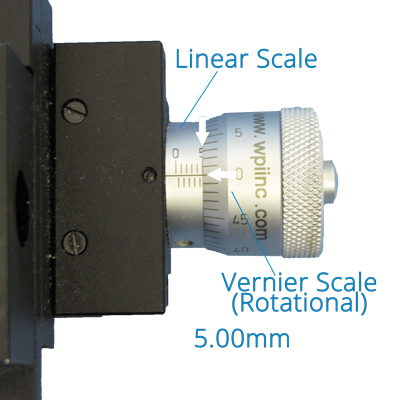
Follow the same steps to read the rotational vernier scale:
- Read the main scale. Look for the last whole or half mark increment visible before the zero mark on the vernier scale.
- Read the secondary scale (Vernier) measurement. This is the value of the scale that lines up with the center line of the main scale.
- Add the two measurements together.
On this micromanipulator, the linear scale is read first. Whole numbers are shown on the top of the linear scale and half numbers are shown on the bottom. In the first image, we see a measurement of 5.0mm. Then we read the rotational scale, which has 50 increments. For this instrument, two complete revolutions of the rotational scale equals 1.0mm mark on the linear scale. That means that each mark on the rotational dial is equivalent to 1/100th of a millimeter. For the example at the right, the 0 mark on the rotational scale lines up exactly with the center line of the linear scale. Therefore, the reading is exactly 5.00mm.
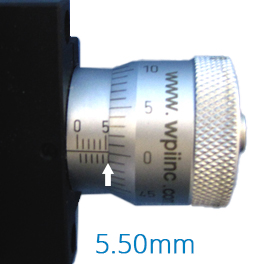
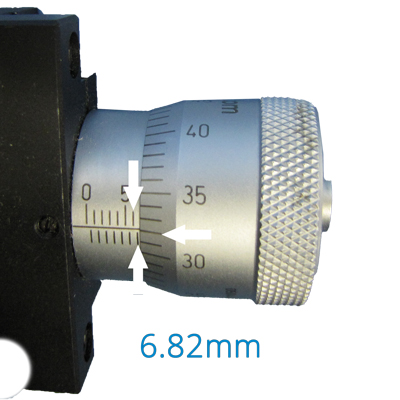 The image (far right) shows a reading at 5.50mm. On the linear scale, the 5 is visible, and you can see the half mark (0.5) on the bottom side of the linear scale. Since the rotational scale is exactly at 0, the final measurement is 5.50mm.
The image (far right) shows a reading at 5.50mm. On the linear scale, the 5 is visible, and you can see the half mark (0.5) on the bottom side of the linear scale. Since the rotational scale is exactly at 0, the final measurement is 5.50mm.
In the last example (right), 6.5 is visible on the linear scale. On the rotational scale, you can read 32, which is equal to (0.32mm). When these values are added together, the final measurement is 6.5 + 0.32, which equals 6.82mm.
In summary, reading a vernier scale measurement is as easy as 1 - 2 - 3!
- Take a main scale reading.
- Take a secondary scale reading.
- Add them up.

Close



